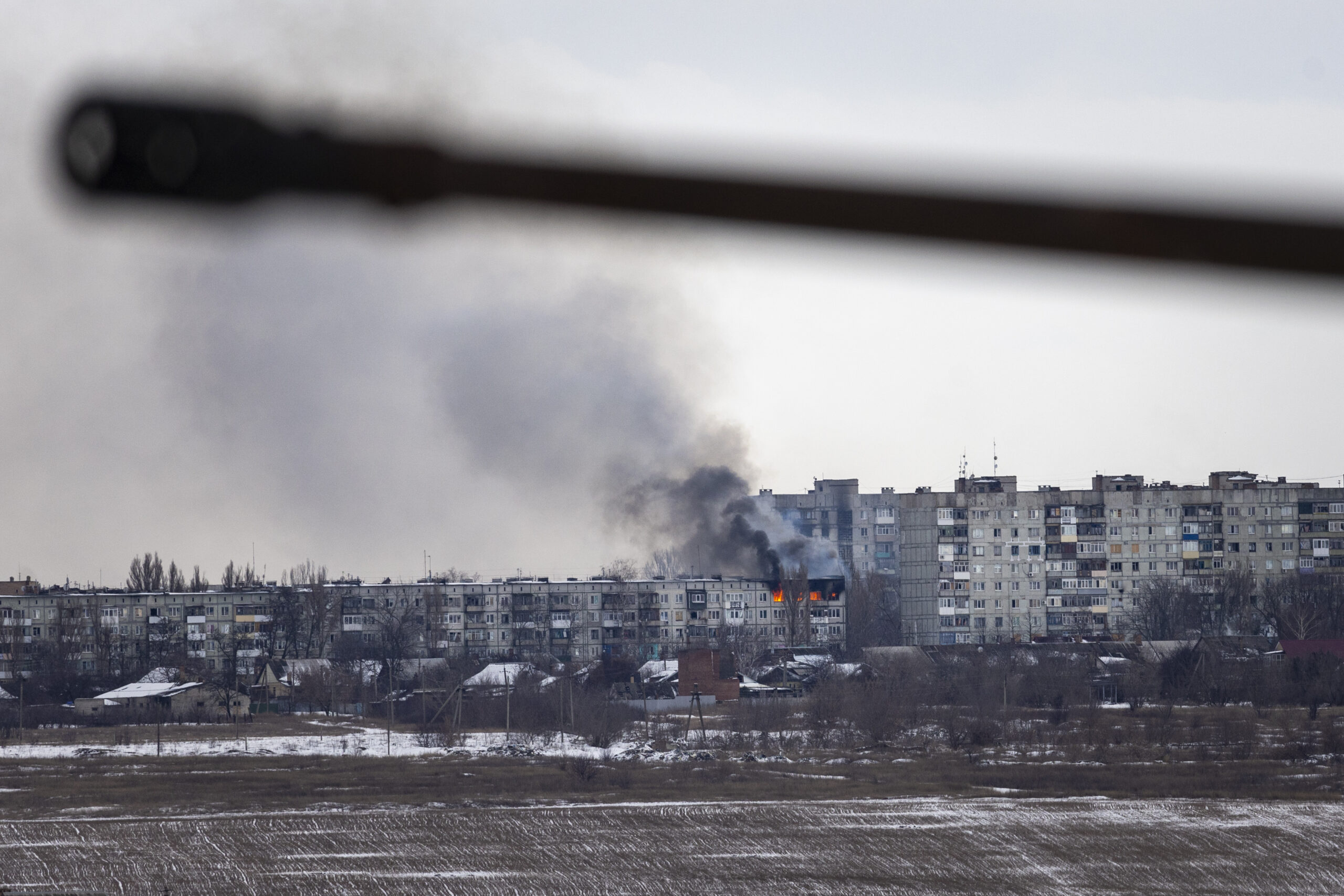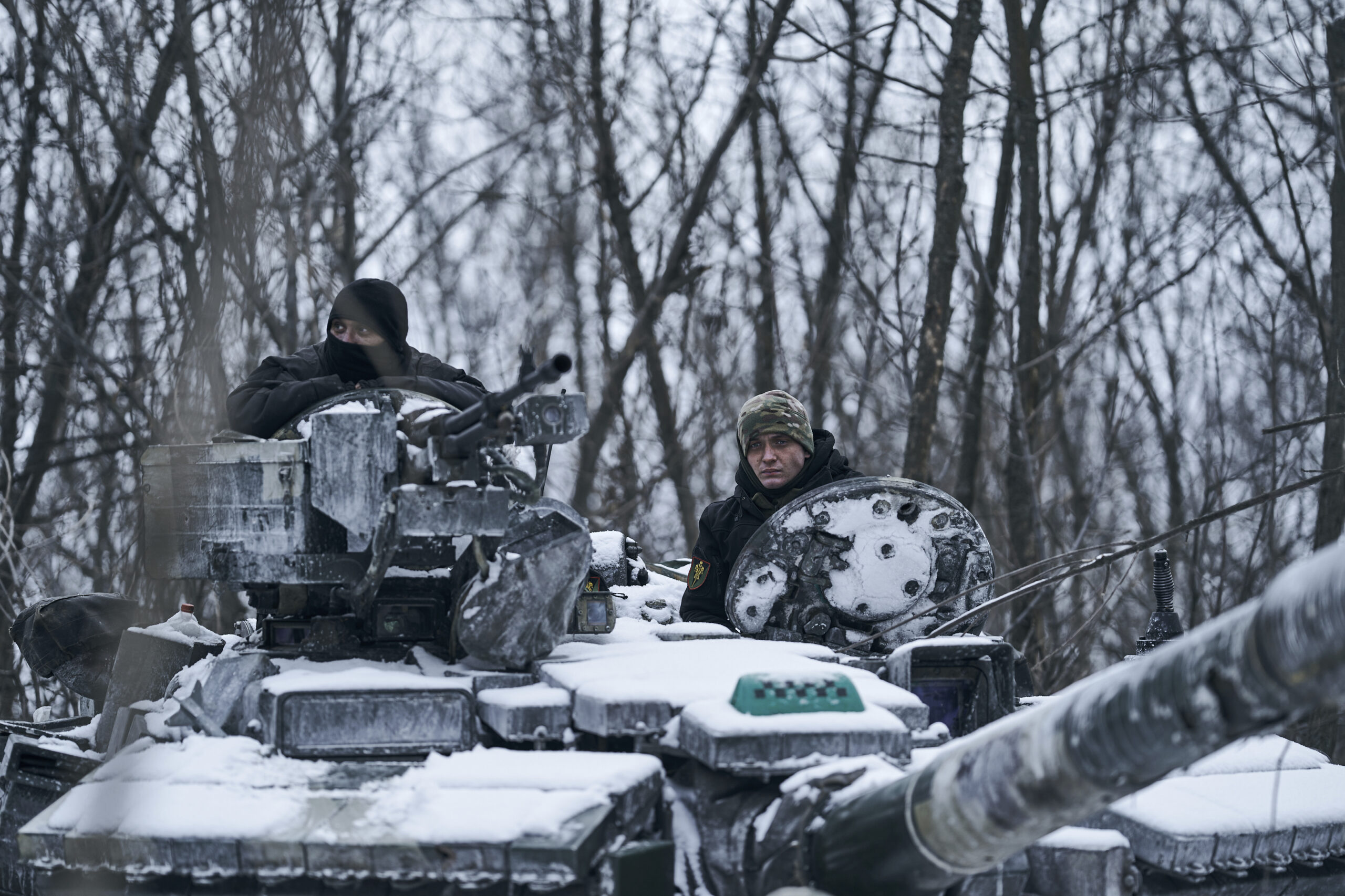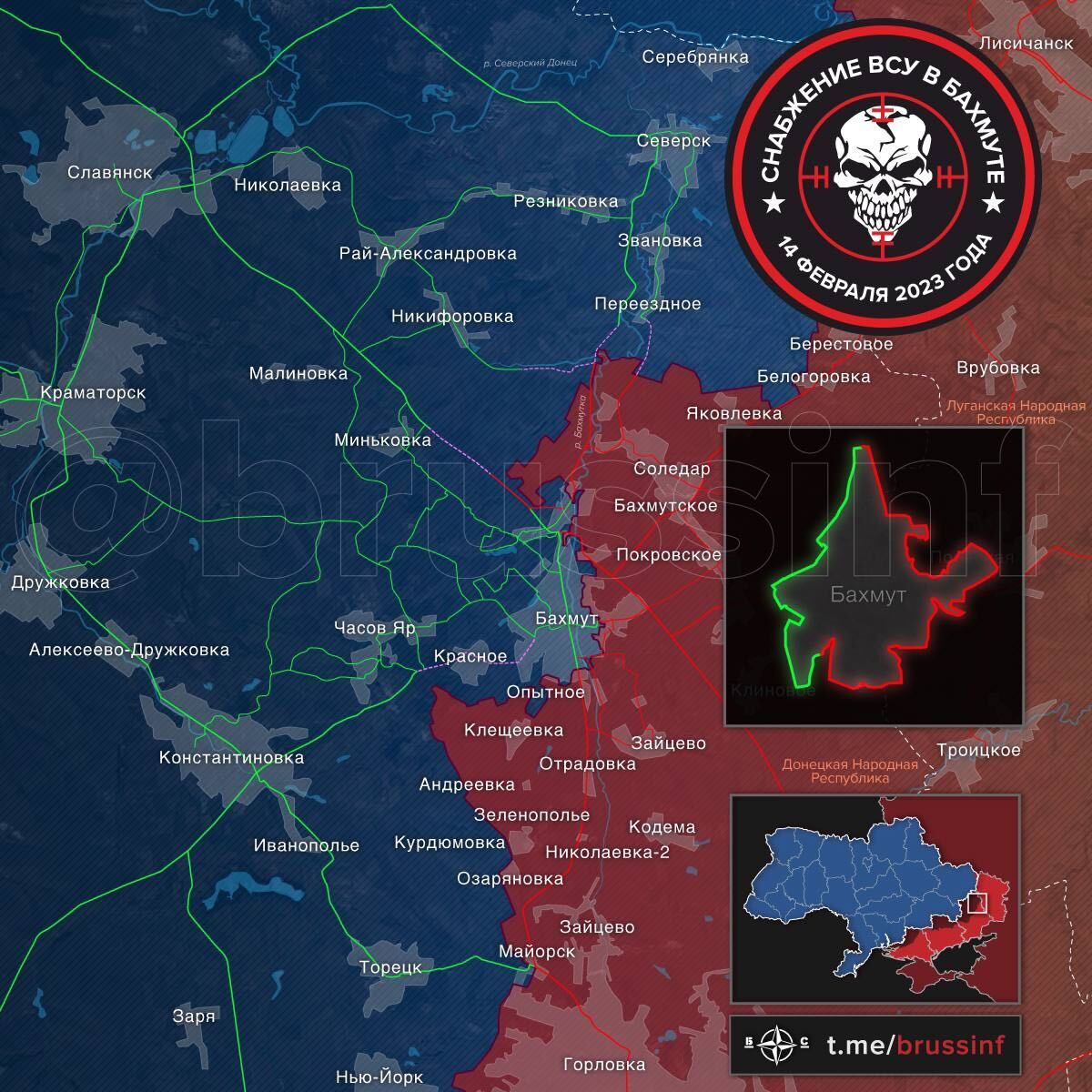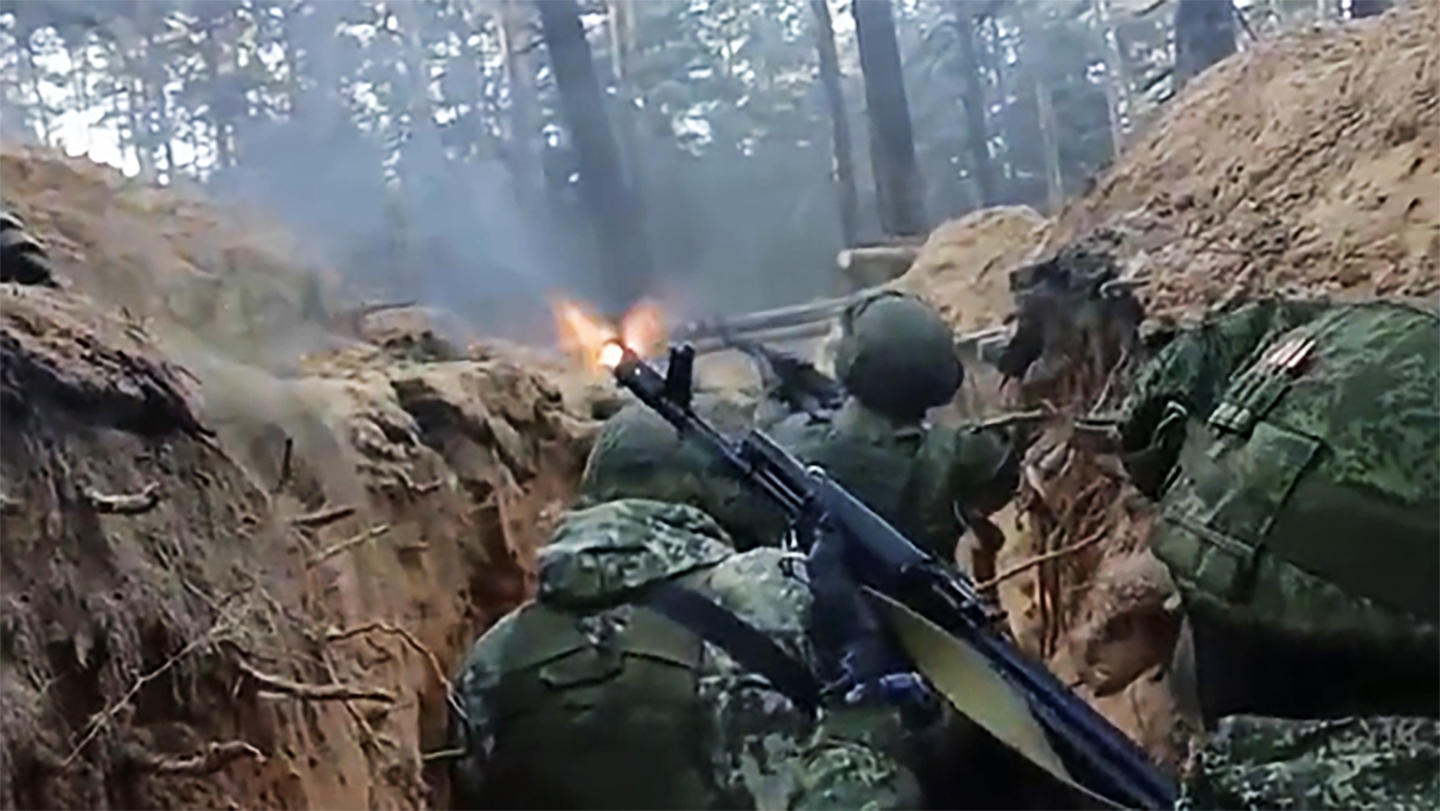There is bloody fighting going on as Russia has unleashed its offensive in the Donbas, but little has changed across the battlefield, Army Gen. Mark Milley, the chairman of the Joint Chiefs of Staff, said Tuesday.
“This offensive you see going on right now [is] generally in the Bakhmut area,” Milley told reporters during a press conference after the ninth Ukraine Defense Contact Group meeting wrapped up in Brussels, Belgium. “From Kharkiv all the way down to Kherson, the front line is quite stable, even though very violent.”

“Most of the dynamic movement back and forth is generally in the vicinity of Bakhmut,” Milley added. “The Ukrainians are holding. They’re fighting the defense.”
The Russians, he said, “primarily the Wagner group, are attacking but there’s a what I would describe as a really a very significant grinding battle of attrition with very high casualties, especially on the Russian side. There’s no fancy arts of maneuver going on here. This is frontal attacks. Wave attacks. Lots of artillery with extremely high levels of casualties in that particular area.”
How long the fighting in Bakhmut will last, said Milley, “is difficult to say actually, it’s been going on for weeks, and I think it will continue to go on until the Russians culminate. I don’t think the Ukrainians will just collapse or fold. I think they’re gonna continue to fight.”
Despite the heavy costs in terms of personnel and equipment Ukraine is incurring while defending Bakhmut, the U.S. is not telling Kyiv what to do there, the White House National Security Council spokesman John Kirby told reporters in Washington Tuesday.
“I am certainly not going to talk about any of the conversations that we have [had] with the Ukrainians,” Kirby said when asked if the U.S. was advising Kyiv to surrender and conserve its resources for an offensive later on this year.
“They decide what operations they’re going to conduct and with what energy and resources they’re going to conduct them,” Kirby said. “We don’t do that for them. We don’t tell them what to do or what not to do.”
Ukrainian President Volodymyr Zelensky “has been very clear about how he regards the fighting,” said Kirby. “He and his military have been fighting bravely to prevent it from falling to the Russians, more specifically to Mr. Prigozhin and his ex-convicts.”

The Russians, however, “are continuing to make incremental progress there. Again, I can’t predict one way or the other whether it falls or doesn’t fall, or what timeline. They have made incremental progress … in just the last 24 or 48 hours.”
Even the pro-Russian Rybar Telegram channel acknowledges that the Wagner mercenary organization, headed by the aforementioned Yevgeny Prigozhin, has yet to completely encircle Bakhmut or establish fire control on all the routes in and out.

Ukrainian troops say they will not surrender the city.
“No one is going to leave the city,” said Volodymyr Nazarenko, deputy battalion commander of the “Svoboda” Defense Forces, according to the Ukrainian UNITED24 Telegram channel. “The city is protected on every street. Every street and every building is a fortress. Very good fortifications throughout the city, this is a multi-layered defense.”
But regardless of Russian progress in Bakhmut, or even if it does fall, the overall situation in Ukraine won’t change that much, Kirby said.
“As we have said before, I think we shall say again today, even if Bakhmut falls it would not have the strategic impact on the overall war,” said Kirby. “I would go so far as to say it won’t even have necessarily a strategic impact.”
Speaking to reporters in Brussels, U.S. Defense Secretary Lloyd Austin downplayed reports that Russia is amassing aircraft in preparation for a new wave of attacks from above.
“In terms of whether or not Russia is massing its aircraft for some massive aerial attack, we don’t currently see that,” he said. “We do know that Russia has a substantial number of aircraft in its inventory and a lot of capability and that’s why we need to do everything that we can to get Ukraine as much air defense capability as we possibly can.”
Ukraine, meanwhile, has its eyes on an offensive of its own, Austin said.
“What Ukraine wants to do at the first possible moment is to establish or create momentum and establish conditions on the battlefield that continue to be in its favor,” Austin told reporters. “And so we expect to see them conducting an offensive sometime in the spring.”
As a result, “all the partners in the Ukraine Defense Contact Group have been working hard to ensure that they have the armored capability, the fires sustainment, to be able to be effective in creating the effects on the battlefield that they want to create,” said Austin. “And so we believe that they’ll be a window of opportunity for them to exercise initiative and then change or continue to create the right conditions on the battlefield.”
Before we head into the latest news from Ukraine, The War Zone readers can get caught up with our previous rolling coverage here.
The Latest
Perhaps the biggest news out of the Ukraine Defense Contact Group meeting in terms of arms being supplied to Kyiv is what’s not being supplied.
At least so far.
“I don’t have any announcements to make on aircraft today,” Austin said, ending speculation that there might be some agreement among the 50-plus nations taking part to send Western fighter jets to Ukraine. “We’re going to continue to work with Ukraine to address Ukraine’s most pressing needs. Again, they’re contemplating an offensive in the spring, and that’s just weeks away. And so we have a lot to get done.”
Austin also shot down the notion that the U.S. was somehow preventing Poland or anyone else from providing Ukraine with fighters.
“For the record, with respect to any kind of aircraft being provided by Poland, the United States never stopped Poland from providing anything,” Austin said. “A decision to provide something is … a decision made by the leadership of that country. That’s certainly not something that we can or will dictate.”
Austin also had nothing new to add to President Joe Biden’s previous “no” answer in response to whether the U.S. would give Ukraine its own F-16s.
“In terms of whether or not we’re going to provide the F-16s, as I said earlier, I don’t have any announcements to make,” he said. “And I don’t have anything to add to what our president said earlier, so I’ll just leave it at that.”
The Financial Times, however, hinted such a decision has not been ruled out.
You can read more about F-16s to Ukraine, and what it would take to train those pilots, in our deep dive here.
As far as announcements about what is being provided to Ukraine in the wake of this latest round of meetings, Austin pointed to “significant new air defense donations” and additional ammunition.
“Italy and France have jointly announced that they will provide Ukraine with a SAMP/T air defense system,” Austin said. “France also announced that it will work with Australia to ramp up 155mm ammunition production to support Ukraine. Finally, we also think Norway, which just announced that it will provide 7.5 billion Euros ($8.05 billion) in military and civilian assistance to Ukraine over the coming five years.”
Yesterday, we wrote about NATO Secretary General Jens Stoltenberg’s statements that Ukraine is using up far more artillery ammunition than is currently being produced.
Austin addressed that Tuesday.
“Ukraine has been at this for a year and so they have used a lot of artillery ammunition,” he said. “We’re going to do everything we can working with our international partners to ensure that we give them as much ammunition as quickly as possible and that we will do everything we can to sustain our efforts there as well.”
Austin added that by giving Ukrainian troops “additional training on maneuver … there’s a good chance that they’ll require less artillery munitions, but that’s left to be seen.”
All told, the U.S. and its allies “have committed nearly $50 billion in lethal assistance to Ukraine since the start of Russia’s all-out invasion last February 24th,” Austin said.
And while there were no announcements about jets or other major new weapons systems to come out of this meeting, Ukrainian President Volodymyr Zelensky thanked the U.S. and allies for all that has been provided and hinted at bigger things to come.
“And as we heard today, Ukraine must be successful. And here we agree: there must be success,” Zelensky said on his Telegram channel. “Not everything about Ramstein can be reported in public. Much of the agreements and discussions should be kept behind closed doors. But I can say for sure that the basic trends remain unchanged.”
During his opening remarks Tuesday, Austin noted the wide assortment of nations who have promised tanks to Ukraine. Ukrainian troops are already training on how to operate and maintain the Leopard 2 tanks they’ve been promised.
Speaking of tanks, Norway quantified its previous commitment of armor to Ukraine.
“Norway will donate 8 tanks and up to 4 special purpose tanks to Ukraine,” according to the Norwegian government. “We are also earmarking funds to ammunition and spare parts,” says Minister of Defence Bjørn Arild Gram.
The special-purpose tanks include those designed for armored engineering and bridge laying.
Before the Ukraine Defense Contact Group meeting started, Germany’s Defense Minister Boris Pistorius announced that Berlin signed contracts with Rheinmetall to restart the production of ammunition for the Gepard (German for cheetah) 1A2 self-propelled anti-aircraft gun systems, or SPAAGs, it has delivered to Kyiv, according to Reuters.
“We will quickly start our own production of Gepard ammunition at Rheinmetall. I am very happy we have been able to guarantee the delivery of this important part of air defense,” Pistorius said before a meeting with NATO ministers in Brussels.
On Monday, The Washington Post reported that the Biden administration “is working with Congress to approve another $10 billion in direct budget assistance to Kyiv and is expected to announce another large military assistance package in the next week and the imposition of more sanctions on the Kremlin around the same time.”
On Tuesday, a senior U.S. defense official told The War Zone that no new types of weapons systems will be announced, but that it will, among other things, contain ammunition for systems already provided or promised.
The first tranche of M2A2-ODS Bradley Fighting Vehicles given to Ukraine by the U.S. are a step closer to arriving on the battlefield. After transiting the Atlantic Ocean, they have left the port of Bremerhaven and are now heading east.
One thing Ukraine won’t be getting any time soon, however, is the Army Tactical Missile System (ATACMS) short-range ballistic missile.
“In recent meetings at the Pentagon, U.S. officials told Kyiv’s representatives that it doesn’t have any Army Tactical Missile Systems to spare,” according to POLITICO, citing “four people with knowledge of the talks.”
Transferring ATACMS to the battlefield in eastern Europe “would dwindle America’s stockpiles and harm the U.S. military’s readiness for a future fight, the people said.”
The Atlantic, working with the Reckoning Project, on Tuesday took a deep dive into the murder and torture of Ukrainian citizens at the hands of Russian occupying forces.
“Over the past 10 months, the Reckoning Project has deployed more than a dozen journalists and field researchers to record detailed testimonies of victims of and witnesses to atrocities in areas of Ukraine that are or were under Russian occupation,” the magazine wrote. “Lawyers and analysts then seek to verify these accounts, with the goal of providing evidence that will be admissible in future court proceedings.”
As its all-out war on Ukraine drags on, Russia is forced to move personnel and equipment from many locations to back-fill losses. The latest appears to be troops from the Kola Peninsula, where Russia’s Olenya Air Base is home to Tu-22M Backfire bombers, but also serves as a staging location for Tu-95 Bears.
“The land forces on Kola are reduced to a fifth of their original numbers before the invasion of Ukraine,” the Chief of the Norwegian Intelligence Service, Vice Admiral Nils Andreas Stensønes told the Barents Observer.
He warned that, as a consequence, Russia may lower the threshold for nuclear escalation.
Embattled Ukrainian Defense Minister Oleksii Reznikov, who attended the Ukraine Defense Contact Group meeting, announced a reshuffle of personnel in the Defense Ministry (MoD).
Current deputy commander of the Ground Forces of the Armed Forces of Ukraine, Lieutenant General Oleksandr Pavlyuk, the founder of the “Return Alive” Foundation Vitaliy Deynega, and media personality Andriy Shevchenko have been added “to strengthen the leadership of the Ministry of Defense,” the Ukrainian Obozrevatel news agency reported.
Reznikov had been rumored to be on the chopping block, to be replaced by Maj. Gen. Kyrylo Budanov, head of Ukraine’s Defense Intelligence Agency (GUR) but it seems unclear now whether or when that will happen.
A Russian Su-24 Fencer strike jet operated by the Wagner mercenary group was severely damaged by a Ukrainian man-portable air defense system (MANPADS) over Bakhmut, according to the Ukraine Weapons Tracker OSINT group.
That is very likely the jet that Wagner capo di tutti capi Prigozhin claimed on Feb. 6 to have flown over Bakhmut in and challenged Zelensky to an aerial duel.
Reports have emerged on social media about the first confirmed destruction of a new Russian Palantin electronic warfare system.
Tanks get a lot of attention, but other armored vehicles still pack a lot of punch, like the Russian BMD-2 and BTR-D seen in this video below.
Trench warfare is brutal, as you can see in this video of Russian troops near Kreminna in Luhansk Oblast.
And finally, Ukraine has long been pressing for F-16s and other Western fighters, a point driven home yet again by this Valentine’s Day ode to air power.
Contact the author: howard@thewarzone.com
